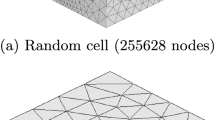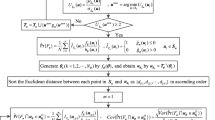Abstract
This paper investigates an effective test strategy for structural failure criterion characterization. The goals include identification of potential failure modes and a better approximation of failure boundary, e.g., failure load mapping with respect to geometry and load conditions. We typically replicate and test the same structural configuration several times in order to deal with noisy observation. However, our study shows that replication is not necessarily needed, because of the smoothing effect of surrogate models, and we show that exploring with as many different configurations as possible is more important. We illustrate the failure criterion characterization with two structural examples with various surrogate models, including polynomial response surface (PRS), support vector regression (SVR) and Gaussian process regression (GPR). We also examine the treatment of replicated test data for surrogate fitting. While fitting to all replicated test data works well for GPR, fitting only to the mean values of the replicated data helps a not-well-tuned surrogate (SVR in this paper) by compensating for the proneness to overfitting. When the noise level is significant as compared to the error due to surrogate modeling, a denser matrix might be prone to overfitting for GPR and SVR.


















Similar content being viewed by others
References
Basudhar A (2012) Selection of anisotropic kernel parameters using multiple surrogate information. Paper presented at the 14th AIAA/ISSMO multidisciplinary analysis and optimization conference, Indianapolis, Indiana, 17–19 September
Chaudhuri A, Haftka R T, Ifju P, Villanueva D, Chang K, Rue J, Tyler C, Schmitz T (2013) Experimental optimization and uncertainty quantification of flapping wing of a micro air vehicle. Paper presented at the 10th World congress on structural and multidisciplinary optimization, Orlando, FL, May 20–24
Cherkassky V, Ma YQ (2004) Practical selection of SVM parameters and noise estimation for SVM regression. Neural Netw 17(1):113–126. doi:10.1016/S0893-6080(03)00169-2
Cherkassky V, Mulier F (2006) Learning from data: concepts, theory, and methods. Wiley, Hoboken
Clarke SM, Griebsch JH, Simpson TW (2005) Analysis of support vector regression for approximation of complex engineering analyses. J Mech Des 127(6):1077–1087. doi:10.1115/1.1897403
Department of Defense (2002a) Department of Defense Handbook, Composite materials handbook, vol 1, Chapter 8 MIL-HDBK-17-3F
Department of Defense (2002b) Department of Defense Handbook, Composite materials handbook, vol 3, Chapter 4 MIL-HDBK-17-3F
Eldred MS, Giunta AA, Wojtkiewicz SF, Trucano TG (2002) Formulations for surrogate-based optimization under uncertainty. Paper presented at the 9th AIAA/ISSMO symposium on multidisciplinary analysis and optimization, Atlanta, GA, 4–6 September
Elfving G (1952) Optimum allocation in linear regression theory. Ann Math Stat 23(2):255–262. doi:10.1214/aoms/1177729442
Forrester AIJ, Keane A J (2009) Recent advances in surrogate-based optimization. Prog Aerosp Sci 45(1–3):50–79
Forrester A I J, Sóbester A, Keane AJ (2008) Engineering design via surrogate modelling: a practical guide. Wiley
Giunta A A, Dudley J M, Narducci R, Grossman B, Haftka R T, Mason W H, Watson L T (1994) Noisy aerodynamic response and smooth approximations in HSCT design. In: Paper presented at the 5th symposium on multidisciplinary analysis and optimization, Panama City Beach, FL, September 7–9
Giunta AA, Mcfarland JM, Swiler LP, Eldred MS (2006) The promise and peril of uncertainty quantification using response surface approximations. Struct Infrastruct E 2(3–4):175–189. doi:10.1080/15732470600590507
Giunta A A, Watson L T (1998) A comparison of approximation modeling techniques: polynomial versus interpolating models. Paper presented at the 7th AIAA/USAF/NASA/ISSMO symposium on multidisciplinary analysis and optimization, St. Louis, MO, September 2–4
Goel T, Haftka RT, Shyy W, Watson LT (2008) Pitfalls of using a single criterion for selecting experimental designs. Int J Numer Methods Eng 75(2):127–155. doi:10.1002/Nme.2242
Gunn SR (1998) Support vector machines for classification and regression. University of Southampton
Hawkins D M (2004) The problem of overfitting. J Chem Inf Comput Sci 44(1):1–12. doi:10.1021/ci0342472
Ilcewicz L, Murphy B (2005) Safety & certification initiatives for composite airframe structure. Paper presented at the 46th AIAA/ASME/ASCE/AHS/ASC structures, structural dynamics and materials conference, Austin, Texas, April 18–21
Jin R, Chen W, Simpson TW (2001) Comparative studies of metamodelling techniques under multiple modelling criteria. Struct Multidiscip Optim 23(1):1–13
Jin R, Du X, Chen W (2003) The use of metamodeling techniques for optimization under uncertainty. Struct Multidiscip Optim 25(2):99–116. doi:10.1007/s00158-002-0277-0
Jordaan E M, Smits G F (2002) Estimation of the regularization parameter for support vector regression. Paper presented at the World conference on computational intelligence 2002, Honolulu, Hawaii, May 12–17
Kiefer J (1961) Optimum designs in regression problems .2. Ann Math Stat 32(1):298–325. doi:10.1214/aoms/1177705160
Kim C, Choi KK (2008) Reliability-based design optimization using response surface method with prediction interval estimation. J Mech Des 130(12):121401–121412. Artn 121401. doi:10.1115/1.2988476
Marshall Rouse DCJ, McGowan DM, Bush HG, Allen Waters W (2005) Utilization of the building-block approach in structural mechanics research. Paper presented at the 46th AIAA/ASME/ASCE/AHS/ASC structures, structural dynamics & materials conference, Austin, Texas, 18–21 April
MATLAB and Statistics Toolbox Release (2012) The MathWorks, Inc., Natick, Massachusetts
Myers R H, Montgomery DC (1995) Response surface methodology: process and product optimization using designed experiments. Wiley, New York
Papila M, Haftka RT (2000) Response surface approximations: noise, error repair, and modeling errors. AIAA J 38(12):2336–2343. doi:10.2514/2.903
Picheny V (2009) Improving accuracy and compensating foruncertainty in surrogate modeling. University of Florida, Gainesville
Picheny V, Ginsbourger D, Richet Y, Caplin G (2013a) Quantile-based optimization of noisy computer experiments with tunable precision. Technometrics 55(1):2–13. doi:10.1080/00401706.2012.707580
Picheny V, Wanger T, Ginsbourger D (2013b) A benchmark of kriging-based infill criteria for noisy. Struct Multidiscip Optim (in press). doi:10.1007/s00158-013-0919-4
Queipo NV, Haftka RT, Shyy W, Goel T, Vaidyanathan R, Tucker PK (2005) Surrogate-based analysis and optimization. Prog Aerosp Sci 41(1):1–28. doi:10.1016/j.paerosci.2005.02.001
Rasmussen C E, Williams C K I (2005) Gaussian processes in machine learning. MIT Press, Cambridge
Sacks J, Welch W J, Mitchell T J, Wynn H P (1989) Design and analysis of computer experiments. Stat Sci 4(4):409–423
Simpson TW, Booker AJ, Ghosh D, Giunta AA, Koch PN, Yang RJ (2004) Approximation methods in multidisciplinary analysis and optimization: a panel discussion. Struct Multidiscip Optim 27(5):302–313. doi:10.1007/s00158-004-0389-9
Smola AJ, Scholkopf B (2004) A tutorial on support vector regression. Stat Comput 14(3):199–222. doi:10.1023/B:Stco.0000035301.49549.88
St. John RC, Draper NR (1975) D-optimality for regression design—review. Technometrics 17(1):15–23
Vapnik V N (1998) Statistical learning theory. Wiley-Interscience, New York
Viana FAC (2010) Surrogates toolbox user’s guide (Ver. 2.1). Gainesville
Viana FAC, Haftka RT, Hamman R, Venter G (2011) Efficient global optimization with experimental data: revisiting the paper helicopter design. Paper presented at the 52nd AIAA/ASME/ASCE/AHS/ASC structures, structural dynamics and materials conference, Denver, Colorado, 4–7 April
Acknowledgments
The authors greatly appreciate the support by National Science Foundation grant CMMI-1131103.
Author information
Authors and Affiliations
Corresponding author
Rights and permissions
About this article
Cite this article
Matsumura, T., Haftka, R.T. & Kim, N.H. Accurate predictions from noisy data: replication versus exploration with applications to structural failure. Struct Multidisc Optim 51, 23–40 (2015). https://doi.org/10.1007/s00158-014-1115-x
Received:
Revised:
Accepted:
Published:
Issue Date:
DOI: https://doi.org/10.1007/s00158-014-1115-x




